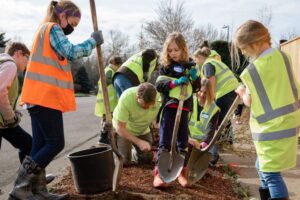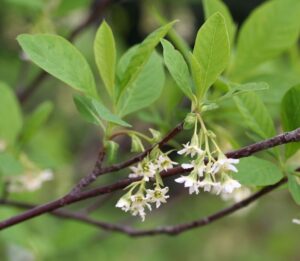Category: Eugene
Preparing Eugene Trees for Climate Change
What we can do in the face of an uncertain future
When it comes to trees, there are so many layers to preparedness, from the near to distant future, from the next heat wave or ice storm to what the climate might look like in 25 years. So much of the future is uncertain, but there’s plenty you can do to prepare your trees for what they might encounter.
“So much is unknowable,” says Eugene Director Erik Burke. “You won’t have the information you need to make your decisions when you make them. You just have to make your best guess.”
The very first decision you’ll make is what tree to plant. Considering trees that are adapted to your climate, and what the climate might be in the future, can set your tree up for a long, healthy life.
“For a while, the estimate was that by 2050, Eugene’s climate might be like Sacramento’s is now,” Erik says. “But that estimate is moving even further south to Stockton.”
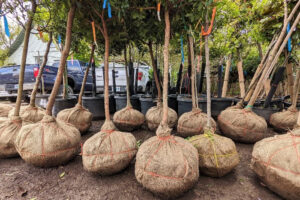
Erik outlines three approaches that planting programs can take to prepare for climate change. The first is diversity for diversity’s sake. Planting a variety of trees means that if any particular species fails due to climate impacts or disease, it won’t take out a huge chunk of the urban forest. The second is very intentionally looking at trees adapted to our native climate and soils, but many of those species aren’t readily available in the nursery trade. The third is planting broadly adapted trees with huge ranges, but many of those trees aren’t drought tolerant, and because many of those trees are clones, they aren’t given the opportunity to adapt from generation to generation.
“Really, we should do some of each approach,” Erik says. “There are trade offs for each.”
What about trees that are already in the ground? How do we prepare our large trees? Our Eugene Team always emphasizes the importance and value of regular pruning. Appropriate pruning will set a tree up to survive in the urban environment and in the face of weather events.
“It’s important to remember that stress is additive. Even if a tree survives, stress can pile up from heat wave to ice storm to heat wave.” Erik says. “That’s why we need to water during heat waves and prune properly after ice storms.”
How we respond to storms is the first step in preparing for the next one. Erik warns that bad pruning after an ice or wind storm can lead to more failure down the line, because limbs won’t be strong enough for the next. Still, he advocates for proper pruning after storm damage rather than removing a tree.
“When you remove a tree, you’re back to square one. But restorative pruning can give that mature tree a chance to continue providing benefits.”
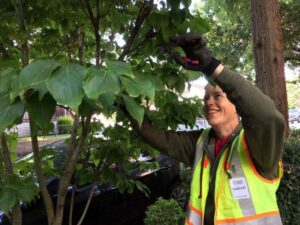
Selection, siting, pruning, protecting soil, and public education. This is how we reach what Erik calls our ultimate goal: to have a healthy relationship with trees. That’s why it’s important to find opportunities to talk about trees.
“Weather and climate is something everyone experiences,” says Taylor Glass, Eugene-Springfield Program Manager. “It’s something to connect over. It’s a way to talk about climate change.”
“My hope is that it will cause us to cooperate more,” Erik says.
“We’re going to have to,” Taylor says.
Spring is coming! Or is it already here?
The Eugene Team shares their favorite signs of springtime
“Many buds are starting to swell,” Erik Burke says when asked when spring will arrive. “Witch-hazel, Persian ironwood and osoberry are all insect-pollinated woody plants that are blooming. Spring is here.”
The Eugene Director has always noted that the seasons aren’t evenly distributed in Western Oregon and Southwest Washington. “We have a short autumn, a relatively short winter, and long springs and summers. November is our wettest month on average, January is our coldest month, and while February can be cold, spring typically begins early in the month.”
Meteorologists observe March 1st as the first day of spring. Our calendars say March 19, the vernal equinox, when the days finally begin to be longer than the nights. But plants are on their own schedule.
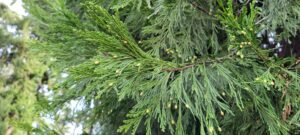
“It’s a gradual roll out,” Erik says. We’ll see camas come out of the ground in December or early January as the incense cedar starts blooming. Filberts pollinate in January, and in February, we’re seeing willows leafing out, and daffodils and cottonwoods blooming.
“When the cottonwood buds drop on the bike path, it’s the best smell ever,” Erik says. “And in March, our native wildflowers are just beautiful.”
Some ecologists point to osoberry blooming as the first sign of spring, because it’s the first native insect-pollinated woody plant to bloom, and blooms with or just after the introduced witch-hazel and Persian ironwood.
“I love when the forest edges are covered in osoberry blooms,” says Taylor, our Eugene-Springfield Program Manager “I love that the days are getting longer faster. I love seeing the native bulbs lush and thriving.”

Spring is when we see the most pollen from the wind-pollinated trees that cause allergies. But luckily, it’s during the rainy season, and rain will knock a lot of those allergens out of the air. Incense cedar is the first to put out its pollen, followed by filbert, cottonwood, alder, birch, and hornbeam. Ash and oak follow in April.
Our early spring allows for most trees and plants to wrap up their reproductive processes by May, ahead of our annual summer drought. Until then, we get to enjoy the kaleidoscope of blooms in our canopy, across our hillsides, and in our own yards and gardens.
MLK Day of Action in a Wintery West Eugene

Justice was top of mind for everyone at the West Eugene Martin Luther King Day planting on Saturday January 20th. The event had been postponed from earlier in the week because of the winter storm that brought ice, frigid temperatures, downed trees, and power outages. Luckily by Saturday, Eugene had thawed out enough for three crews of volunteers to plant 25 trees in their community.
“It was cold, but everyone was so excited and kept up their spirits,” says Eugene Director Erik Burke.
After a week of harsh winter weather, people were excited to get outdoors. The planting started at Berkeley Park in West Eugene, a high priority planting area. Spurred by a call to do something for their community, all three crews traveled to their planting sites on foot rather than in cars. The intimate events that our Eugene team hosts create an atmosphere of connection that is perfect for the MLK Day holiday.
Much of the conversation that day was about the winter storm and the hardships people either avoided or endured depending on how lucky they were.
“Downed trees aren’t just a tree maintenance issue or a climate change issue,” Erik says. “It’s a justice issue. Trees that don’t receive proper care are more likely to fail. If we want everyone to have access to the benefits of trees, we need to make sure that tree care and maintenance is available too.”
Just like we do at every planting event, we highlight how planting trees is just the beginning. Tree care and community stewardship is the path to long-lasting trees, whose benefits increase exponentially as they mature. Planting is climate action worthy of a day of service. Caring for trees and communities is a daily practice.
Returning to a Natural Area in Springfield
Can I get a refill?
Next month, volunteers will be planting trees, shrubs, and understory near a major intersection on the Bob Straub Parkway in Springfield. But they won’t be starting from scratch—this location has already been the site for four planting events in the past six years. You’ve heard us say it before at Friends of Trees, we don’t just plant and walk away. But what exactly does that mean? It means post-planting care, stewardship training, and in the case of many natural area plantings like this one, it means infill planting.
Infilling is sort of like refilling, not that this site is empty. Thanks to enthusiastic past volunteers who planted it and neighbors of the planting site who have protected it, it’s already a beautiful spot.
“This is one of our most successful Green Space plantings,” says Eugene Director Erik Burke. “It’s in the floodplain, and it has really good soil. Overall, things are growing really well.”
That doesn’t mean that the site isn’t worthy of some replanting. At natural area plantings like this one, we plant in pods that have multiple levels: trees, shrubs, and herbaceous understory with things like milkweed and camas. At the Bob Straub planting site, a few trees need to be replaced and some of the shrubs and flowers could use some support.
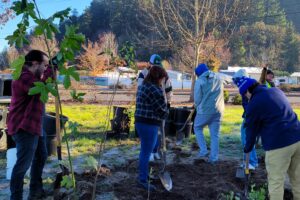
“We really want to create a rich, robust planting area,” Erik says. “It’s so satisfying to create these dense clusters of plants.”
We plant these pods similar to the Miyawaki Method, which aims to mimic how a forest would rebuild itself if people stepped away. It’s all about establishing a community of trees and plants, which is fitting because a community of people plant it, care for it, and benefit from it.
“Like with all of our plantings, it’s important to make sure that they have a lasting impact,” Erik says. “That’s why we return.”
Pedal Power in Eugene
A new E-Bike grant gives our Eugene team even more Pedal Power!
Our Eugene-Springfield team just received an Electric Mobility Grant from the Eugene Water & Electric Board. The team will receive two new electric bicycles to use for pedal powered planting. Our Eugene plantings already feature robust bicycle use and these new e-bikes will expand our plant-by-bike program even more.
“It’ll be great to be able to use these new e-bikes to haul trees at planting events,” says Eugene-Springfield Program Manager Taylor Glass. The team has borrowed e-bikes from partners in the past so they know exactly how useful they can be.
“Eugene has a fair amount of hills,” says Eugene Director Erik Burke. “It can be a fun challenge on a regular bike, but I’ve had to get off to push a bike trailer up a big hill.”
“The e-bikes can go further and up hills and that just opens up more possibilities for where we can plant by bike,” Taylor says. “And it will give volunteers an opportunity to try them out.”
Beyond planting events Friends of Trees staff will be able to use the e-bikes for things like site inspections, outreach events, and pruning. Reducing how often we drive as part of the sustainability goals for Friends of Trees.
“You really get to know the city better when you’re biking through it rather than driving,” Erik says.
Want to get in on the action this season? Check out our planting event calendar. Do you want to step up and lead a planting crew? Crew leader training is November 29th.

